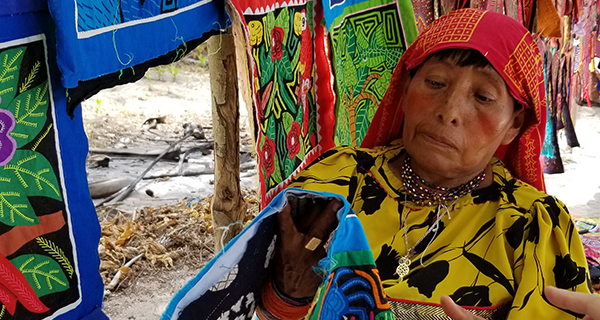 Jesus Prestan is a stranger in his own land.
Jesus Prestan is a stranger in his own land.
Born a member of the Guna (pronounced Kuna) indigenous people on the off the eastern coast of Panama, he grew up and was educated in Panama City. Now, when he returns to the islands that are home to his people, he’s treated politely, but as a visitor.
More than 50,000 people lived on 42 of the 365 islands that comprise San Blas when the last census was taken in 2010. Each year, the number declines as young people move to the city to go to school and choose to stay in the modern world.
Life on the islands is by comparison primitive. The Gunas earn what little income they need from a growing tourism industry and the trade in coconuts with Panama. The houses, made of sour cane walls and roofs of royal palm, have none of the middle-class fixtures we take for granted – like indoor plumbing and appliances. Medicines are derived from native plants and births are overseen by midwives.
Like the people of Quebec in Canada, the Guna consider themselves a nation within a nation. Exploited and oppressed in the early 20th century, the Guna achieved autonomy and “claimed” their land – the islands and a narrow strip of mainland on the coast – after a violent uprising in 1925.
“As we are part of Panama, we consider ourselves Panamanian,” said Prestan. “But we are Guna.”
Their culture remains unique. They resisted conversion to the Catholic religion, maintaining their belief in their creator, Babdumad. They also nurture their own language, Dulegaya. And they have a so-called third gender, omeggid – men who dress as women and have female mannerisms and responsibilities.
For many years, the Gula steadfastly remained distant from the modern world. Until the 1940s, tourists were banned and even today no non-Gunas are allowed to rent or own land under Guna jurisdiction. Today, tourism is a growing portion of their total income. Local craftspeople meet tourists and sell colourful and intricate pieces of attire, such as the mola (blouse). Cruise ships are taxed thousands of dollars for the right to visit an island.
The Guna moved to their home in the islands in the 1500s after losing a struggle with a competing indigenous group. The area has served them well, but the future is looking far less certain.
Climate change is being blamed for the slow dissolution of the beautiful coral reefs that surround many of the islands. And sea waters threaten to ultimately cover all of their home. In fact, on at least one occasion in recent years all the islands were temporarily under water.
Prestan said the Gula are negotiating with the Panamanian government to be granted a larger place to live on the mainland. But those talks are very early and the outcome is uncertain.
“When the younger generation goes to Panama City to be educated, the whole family moves,” said Prestan. “The population is shrinking.”
Between the draw of modern comforts for the young people and the ever-encroaching sea, the Gula may soon find themselves without a home and without a new generation for the first time in half a millennium.
The writer was a guest of the destination. Content was not subject to approval. Doug Firby is president of Troy Media Digital Solutions and publisher of Troy Media.
The views, opinions and positions expressed by columnists and contributors are the author’s alone. They do not inherently or expressly reflect the views, opinions and/or positions of our publication.








